I’m so in awe of my gorgeous neighborhood! We have edibles growing all over and I never knew this until I became an herbalist! Even during a pandemic we can go out and harvest (ethically and responsibly!) these growing plants to supplement and sustain us.
My only caveats in the following article, please don’t harvest plants that are within fifty (50) feet of the roadbed. These can contain contaminants that can’t be washed off, and see my note about Elderberry at the end.
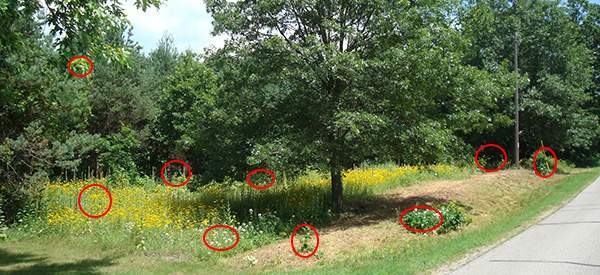
15 Common Wild Plants You Never Thought Were Edible
POSTED 5 HOURS AGO BY CLAUDE IN ALL ARTICLES, BACKYARD PLANTS0
If ever in a situation where you are lost or stranded in the woods or when SHTF, then you will be looking for alternative food sources. There are several things around you that you can eat, but you may have never considered. Wild plants are one such example. These can provide you with the needed nutrients and such, to keep you and your family from starving.
When foraging for these wild edibles it is important to remember that some of these plants will require some basic work before consuming, such as stripping down roots to get to the starchy substance in the middle, or even some grinding of some plant parts before consumption.
#1. Ramps
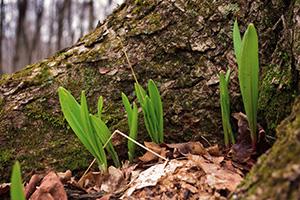
Ramps can be foraged for in the spring. They are kind of a mix between onion and garlic in flavor. The roots grow just below the soil and they grow in patches together.
When digging ramps, it is ideal to conserve the patch by cutting off the root ball with a sharp knife and taking the plant only; this is so you can come back to the same patch next spring. Every part of the ramp is edible and can be eaten raw or used in recipes.
#2. Clover
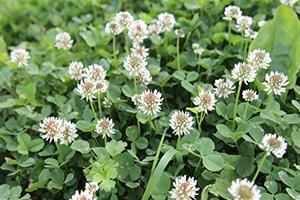
There are different types of clover that grow in your yard, such as red clover and white clover. This is distinctive based on the color of the flower. Simple really. And not just livestock or wild rabbits can eat clover. The whole plant is edible and is best eaten while fresh or completely dried out.
Clover is very healthy for you as it helps ward off colds, reduce respiratory problems, and it is even said that it can purify blood and help ward off cancer. You can grind the leaves to make flour, but it’s a long process. The flower is the best part to eat. When preserving, you can dry the plant and flower head separately. Use a dehydrator, screen in a drying room, or very low temperatures in the oven. Once the plant is dried, you can store it in jars for use over the winter too.
#3. Purslane
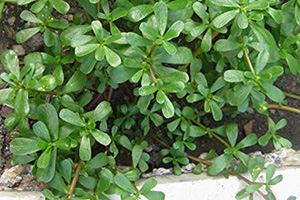
Purslane is identified by the smooth reddish stems and leaves, that are opposite of each other. The flower is yellow with five regular parts and it opens any time of the year at the center of the leaf cluster. Purslane is a ground cover and has a deep root system. The stem, leaves, and flower buds are edible. You can eat it raw in a salad, use in a stir fry, or cooked in soups and other recipes. Purslane has a slightly sour taste. Raw purslane is 93% water.
#4. Daisies
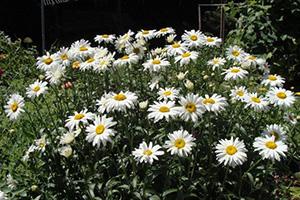
The daisy is a childhood favorite of mine. I used to pick it for my mom and grandmas. I didn’t know you could eat them back then. The flower petals can be used as a garnish or in salads, and the leaves can be used on sandwiches or in salads. It is not recommended that you eat the yellow center of the daisy, as this is the pollen section of the flower.
#5. Cattails
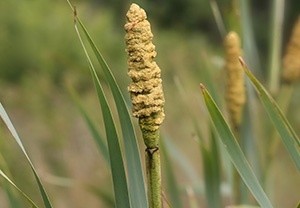
If you have seen a body of water you have probably seen a cattail. The lower leaves can be used in salads, while the stem can be eaten raw or boiled. The cattail itself (the brown cigar shape at the top) can be roasted.
The yellow pollen that appears in midsummer can used as a thickener, and in bread and pancake mixes. The roots contain a lot of starches and can be dried and then pounded into flour, or you can strip it off and chew on it to get the starches and then spit out the tough part. Here are 10 delicious recipes you can make using cattails.
#6. Lamb’s Quarters
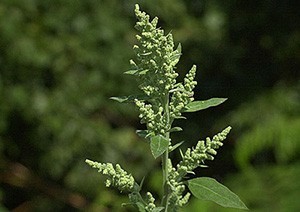
This wild edible looks dusty from a distance due to the white coating on the leaves. The plant produces little green flowers that are grouped together in clusters on the stem and upper branches. When eating lamb’s quarter, you can consume the leaves, shoots, seeds, and flowers. This plant does contain oxalic acid, but when cooked the acid goes away. You can blanch and freeze the leaves for later use. Lamb’s quarter is also good for salads and soups. It can also be sautéed or steamed, as well as a valuable addition to smoothies and juices.
#7. Milk Thistle
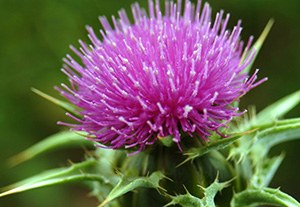
Milk Thistle is good for medicinal purposes but also for eating. You can eat the leaves and flowers as vegetables in a salad. The seeds can also be roasted and used as a coffee substitute, or dried to eat as a snack. The plant has large bright purple flowers, and the leaves have white markings. When broken, a milky sap comes out.
#8. Wild Asparagus
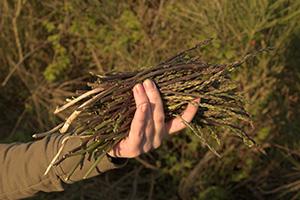
Wild asparagus is edible. It is basically a plant that got transplanted from a seed head which traveled, and from there it started growing in the wild. You will find it along roads and in fields.
Look for the asparagus in the late spring to harvest it. If it gets too big, it is going to seed again. And you can return the next spring for a new harvest. Prepare the wild asparagus grilled or baked and seasoned. To store any extra wild asparagus, you can blanch it and freeze it, or seal in vacuum bags.
#9. Goldenrod
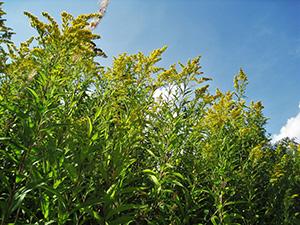
This plant can grow from 24 to 30 inches in height. It is topped with golden flowers that grow in clusters. The leaves taper to a point and have small teeth on the edge. The bottom of the leaf is kind of hairy and rough on the top, with three veins that run parallel along the length of the leaf. Goldenrod can be preserved in about any form, from drying to pickling. Dried flowers and leaves can be added to any meal for a nice flavor. They can also be used for tea. The roots can be harvested when young and dried, and used for soups and batter mixes. Leaves and flowers can be used in salads and soups. The stalk is tough but edible, especially if harvested young. It can be baked in the oven and made into a crispy snack.
#10. Chickweed
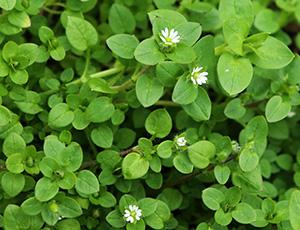
Chickweed is best eaten fresh, but you can also eat it raw. The stem, leaves, flowers, and seed pods can be consumed. You can eat it raw in salads, or you can steam or sauté it. Simply take scissors and cut the amount that you desire.
Chickweed has little white flowers with five double lobes. The leaves are pointed and oval shaped. They grow in pairs across from each other. The leaves grow far apart on the length of the stem. There is a hairy type line that runs up the stem between the leaves.
#11. Stinging Nettles
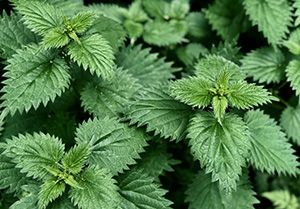
The stinging nettle gets its name by the fact that it has little hairs or spines that irritate your skin, and can even leave welts due to a toxin in them. It is recommended that you only pick the top five to six leaves from the plant, when it is young and before the flowers start to form. To prep the nettles, simply soak them in cold salted water and then drain and dry them. You can freeze them for later use or use them immediately. Stinging nettles can be used as a replacement for spinach, and once cooked they lose their stinging ability.
Related: How to Cook Spring Nettles
#12. Queen Anne’s Lace
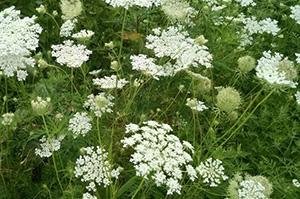
Queen Anne’s lace is also known as wild carrots. This plant has a large flat white flower, with a red or dark center. The stalk is hairy and the root resembles a carrot. It is best to eat the root in the first year, as in the second year it becomes more tough. The green tops are also edible, as you can boil them in soups and stews, or as greenery to dishes. If the stem is not fuzzy or hairy, then it is not Queen Anne’s lace and could be poisonous.
#13. Sorrel
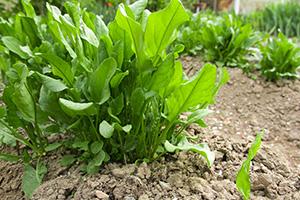
Sorrel is a plant that consists of leafy greens. It has an intense lemony flavor, that becomes more bitter as the leaves age and grow. The smaller leaves can be eaten raw in salads or on sandwiches. The larger leaves should be cooked to help get rid of the bitterness. There are three types of sorrel: red veined, broad leaf, and french. The red veined is self-explanatory, with a slender tapered leaf with red veins throughout it. The broad leaf has slender arrow shaped leaves. The french sorrel has small bell-shaped leaves.
#14. Watercress
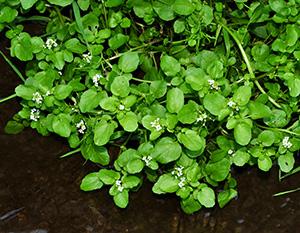
Watercress has a peppery green flavor that goes great with other neutral greens. It can be found all year round in the stores, but it is best in the spring. It is a water grown leafy vegetable, hence the name. If watercress becomes wilted, simply shake it back with cold water, or wrap it in a damp paper towel and place it in a plastic bag.
You can use watercress by washing it and patting it dry, and then use it raw on sandwiches or in salads, sautéed or steamed.
#15. Berries
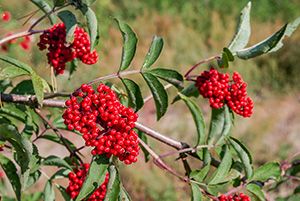
We all have picked blackberries and raspberries, but there are other berries growing in your backyard that are perfectly safe and healthy to eat. Elderberries are ready for harvest in the fall. They grow on shrubs and are a purple to black berry that grows in clusters.
The elderberries must be ripe before consuming, and need to be cooked. This is what kills the astringent poison that they hold. Elderberries are great in syrups, wines, and in cobblers, pies and puddings.
There are many other plants and wild edibles that you can forage for. I am sure most of you can name at least two others that are not here. What other edibles can you name?
Article from The Lost Herbs, www.thelostherbs.com
Note on Elderberries: I use elderberries all the time in teas, tinctures, and syrups Generally in dry form though. Even when raw they do not need to be cooked prior to consumption – it is the seeds that sometimes cause problems. “Elderberries and elderflowers are generally safe for everyone. The raw seeds can make some people nauseous if they eat too many of them. Cooking them diminishes this effect. I have heard from a couple of people that the commercially bought elderberry powder can cause vomiting (presumably due to the seeds in the powdered product). Herbmentor.com Herbal Info: Elder” If you are concerned about raw elderberries, then please follow your instincts and cook them first.

Kathy is an herbalist/naturopathic practitioner who is constantly researching to expand her knowledge. She came to herbalism after her migraine medicine was suddenly removed from the market and she had to find something new. After discovering the magic of herbs she’s never looked back. She is accredited by the International Practitioners of Holistic Medicine (IPHM) and is an Associate Member of the American Herbalist Guild.